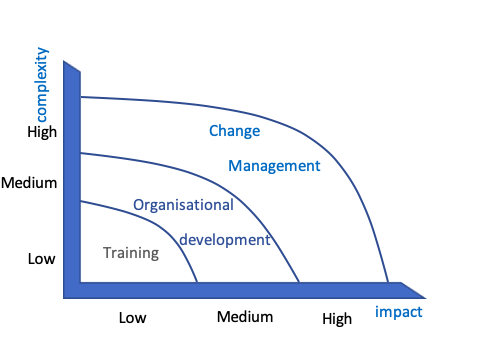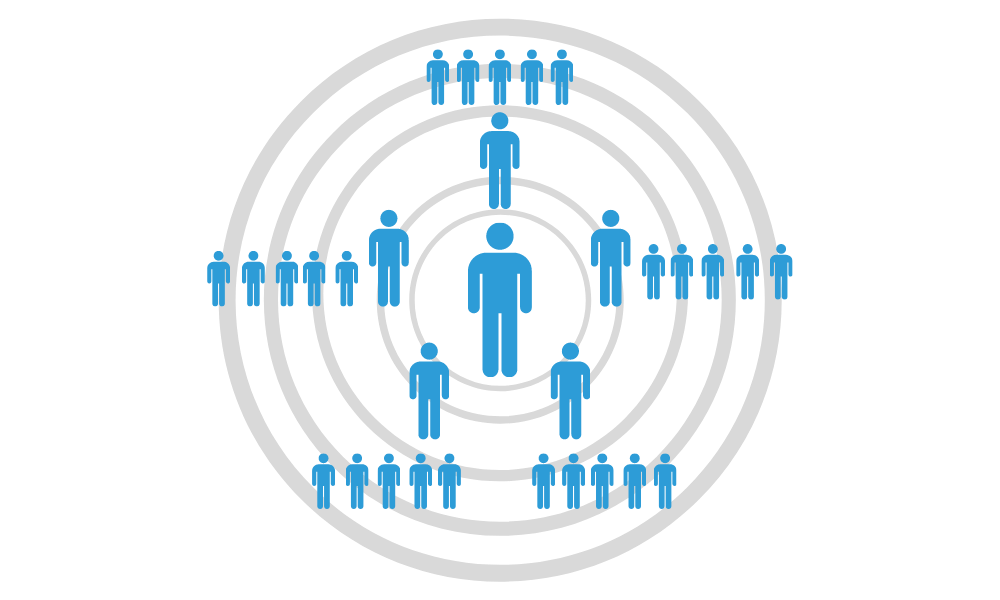
You don’t always need change management. Even if you target fast sustainable results, it’s often better to take a different route. We’ll discuss three steps towards the sustainable implementation of new ways of working: training, organisational development, and change management.
Everybody is talking about change management… Leaders know change management is the basis on which you build sustainability… Knowing that half of your workforce will become genY in a couple of years, it is clear that the need to change is immanent.
But HOW? WHEN?
When do you need change management?
First of all, not every change requires “change management”.

Low impact, Low complexity: TRAINING
- If your projects impact procedures (eg new credit checking procedure);
- If you install new techniques or new tools (thickness measuring by infra-red), new devices (a new registration system for complaints),
- If you create variants on processes (eg new sales flow for semi-finished products shipped immediately to the client with a letter of credit).
In brief, if your people need to gain knowledge, or the need to learn new skills, they need TRAINING!
How to set up good training
To set up a good training, it is important to first look at how the process is executed today, in order to be able to determine the gap between today and the future way of working. This exercise will allow you to focus the setup of your training on the needs of your users.
Good trainings are based on good supporting documentation. This documentation should include procedure descriptions, process flows and screenshots or pictures describing the sequential steps in detail. Make sure people fully understand what the new way of working will look like.
At best, you build all your trainings in 5 layers:
a. High level description
High level description of the objective, the reason why this procedure has changed, who is impacted, and the place of this element in the entire process flow. This will allow people to position the change into the right frame for them.
b. The procedure
Description of the step(s) in the process flow, including all decision points and a detailed explanation of each step in this new procedure.
c. Demonstrations
Demonstrations, showcases of real live examples, and some use cases where trainees can copy the examples into. These examples allow the trainees to mimic the new skills, by copying each move, each keystroke.
d. Practice
This covers the activities that will need to be performed or executed by the trainee. A number of real life examples have to be practiced -end to end- by the trainees and autonomously without help from others (using their own documentation).
e. Exam
Always include an exam (call it a “ test” – that sounds less frightening), to make sure the training was successful, and knowledge has been transferred. Assess the risk on business continuity issues, should some co-workers be unable to use the new system at go live.
These trainings can be organised in a classic theatre setting, online or offline, internally or externally… The ideal way of training people is driven by culture, geographical situation, the need for guidance and the number of people attending.
Anyhow, make sure the standardized documentation is readily available for all stakeholders. It is important to keep existing documentation up to date for different purposes such as the introductory trainings for newbies, quality manuals, (ISO) certifications and where applicable security systems.
In ERP systems it is advisable to have a playground (sandbox with relevant data) for key users in order to allow them performing a lot of exercises as they are the ‘first’ experts on site when training or support needs to be given.
If you set up such trainings, bare in mind some simple trainer rules:
- Offer the entire meal in bite-sized chunks: Present the knowledge in small pieces. Understand that we remember best what is served at the beginning, and at the end.
- We don’t like boring stuff. And it’s harder to retain!
- Students need breaks, and they need company…
The concept of “Train the Trainer”

If you have large numbers of trainees, it’s probably useful to use the exponential training method. The most knowledgeable person(s) trains a small group (5 – 8) to-be-trainers, who then, at their turn, train the regular end users. Your capabilities now have gone 5 to 8fold!
This concept is helpful to have trainers in several languages, and the trainers are internal people. You not only created a number of highly knowledgeable employees with a new skill enabling them to train other users. At the same time, you will have added a boost of confidence and engagement to your organisation!
Next time, we’ll work on the next step in the complexity/complicated diagram: the medium level, where training is still required, but not enough….

You don’t always need change management. Even if you target fast sustainable results, it’s often better to take a different route. We’ll discuss three steps towards the sustainable implementation of new ways of working: training, organisational development, and change management.
Everybody is talking about change management… Leaders know change management is the basis on which you build sustainability… Knowing that half of your workforce will become genY in a couple of years, it is clear that the need to change is immanent.
But HOW? WHEN?
When do you need change management?
First of all, not every change requires “change management”.

Low impact, Low complexity: TRAINING
- If your projects impact procedures (eg new credit checking procedure);
- If you install new techniques or new tools (thickness measuring by infra-red), new devices (a new registration system for complaints),
- If you create variants on processes (eg new sales flow for semi-finished products shipped immediately to the client with a letter of credit).
In brief, if your people need to gain knowledge, or the need to learn new skills, they need TRAINING!
How to set up good training
To set up a good training, it is important to first look at how the process is executed today, in order to be able to determine the gap between today and the future way of working. This exercise will allow you to focus the setup of your training on the needs of your users.
Good trainings are based on good supporting documentation. This documentation should include procedure descriptions, process flows and screenshots or pictures describing the sequential steps in detail. Make sure people fully understand what the new way of working will look like.
At best, you build all your trainings in 5 layers:
a. High level description
High level description of the objective, the reason why this procedure has changed, who is impacted, and the place of this element in the entire process flow. This will allow people to position the change into the right frame for them.
b. The procedure
Description of the step(s) in the process flow, including all decision points and a detailed explanation of each step in this new procedure.
c. Demonstrations
Demonstrations, showcases of real live examples, and some use cases where trainees can copy the examples into. These examples allow the trainees to mimic the new skills, by copying each move, each keystroke.
d. Practice
This covers the activities that will need to be performed or executed by the trainee. A number of real life examples have to be practiced -end to end- by the trainees and autonomously without help from others (using their own documentation).
e. Exam
Always include an exam (call it a “ test” – that sounds less frightening), to make sure the training was successful, and knowledge has been transferred. Assess the risk on business continuity issues, should some co-workers be unable to use the new system at go live.
These trainings can be organised in a classic theatre setting, online or offline, internally or externally… The ideal way of training people is driven by culture, geographical situation, the need for guidance and the number of people attending.
Anyhow, make sure the standardized documentation is readily available for all stakeholders. It is important to keep existing documentation up to date for different purposes such as the introductory trainings for newbies, quality manuals, (ISO) certifications and where applicable security systems.
In ERP systems it is advisable to have a playground (sandbox with relevant data) for key users in order to allow them performing a lot of exercises as they are the ‘first’ experts on site when training or support needs to be given.
If you set up such trainings, bare in mind some simple trainer rules:
- Offer the entire meal in bite-sized chunks: Present the knowledge in small pieces. Understand that we remember best what is served at the beginning, and at the end.
- We don’t like boring stuff. And it’s harder to retain!
- Students need breaks, and they need company…
The concept of “Train the Trainer”

If you have large numbers of trainees, it’s probably useful to use the exponential training method. The most knowledgeable person(s) trains a small group (5 – 8) to-be-trainers, who then, at their turn, train the regular end users. Your capabilities now have gone 5 to 8fold!
This concept is helpful to have trainers in several languages, and the trainers are internal people. You not only created a number of highly knowledgeable employees with a new skill enabling them to train other users. At the same time, you will have added a boost of confidence and engagement to your organisation!
Next time, we’ll work on the next step in the complexity/complicated diagram: the medium level, where training is still required, but not enough….


